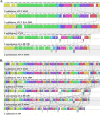Comparative genomics of the dairy isolate Streptococcus macedonicus ACA-DC 198 against related members of the Streptococcus bovis/Streptococcus equinus complex
- PMID: 24713045
- PMCID: PMC4051162
- DOI: 10.1186/1471-2164-15-272
Comparative genomics of the dairy isolate Streptococcus macedonicus ACA-DC 198 against related members of the Streptococcus bovis/Streptococcus equinus complex
Abstract
Background: Within the genus Streptococcus, only Streptococcus thermophilus is used as a starter culture in food fermentations. Streptococcus macedonicus though, which belongs to the Streptococcus bovis/Streptococcus equinus complex (SBSEC), is also frequently isolated from fermented foods mainly of dairy origin. Members of the SBSEC have been implicated in human endocarditis and colon cancer. Here we compare the genome sequence of the dairy isolate S. macedonicus ACA-DC 198 to the other SBSEC genomes in order to assess in silico its potential adaptation to milk and its pathogenicity status.
Results: Despite the fact that the SBSEC species were found tightly related based on whole genome phylogeny of streptococci, two distinct patterns of evolution were identified among them. Streptococcus macedonicus, Streptococcus infantarius CJ18 and Streptococcus pasteurianus ATCC 43144 seem to have undergone reductive evolution resulting in significantly diminished genome sizes and increased percentages of potential pseudogenes when compared to Streptococcus gallolyticus subsp. gallolyticus. In addition, the three species seem to have lost genes for catabolizing complex plant carbohydrates and for detoxifying toxic substances previously linked to the ability of S. gallolyticus to survive in the rumen. Analysis of the S. macedonicus genome revealed features that could support adaptation to milk, including an extra gene cluster for lactose and galactose metabolism, a proteolytic system for casein hydrolysis, auxotrophy for several vitamins, an increased ability to resist bacteriophages and horizontal gene transfer events with the dairy Lactococcus lactis and S. thermophilus as potential donors. In addition, S. macedonicus lacks several pathogenicity-related genes found in S. gallolyticus. For example, S. macedonicus has retained only one (i.e. the pil3) of the three pilus gene clusters which may mediate the binding of S. gallolyticus to the extracellular matrix. Unexpectedly, similar findings were obtained not only for the dairy S. infantarius CJ18, but also for the blood isolate S. pasteurianus ATCC 43144.
Conclusions: Our whole genome analyses suggest traits of adaptation of S. macedonicus to the nutrient-rich dairy environment. During this process the bacterium gained genes presumably important for this new ecological niche. Finally, S. macedonicus carries a reduced number of putative SBSEC virulence factors, which suggests a diminished pathogenic potential.
Figures



Similar articles
-
Comparative genome analysis of Streptococcus infantarius subsp. infantarius CJ18, an African fermented camel milk isolate with adaptations to dairy environment.BMC Genomics. 2013 Mar 22;14:200. doi: 10.1186/1471-2164-14-200. BMC Genomics. 2013. PMID: 23521820 Free PMC article.
-
Genomics, evolution, and molecular epidemiology of the Streptococcus bovis/Streptococcus equinus complex (SBSEC).Infect Genet Evol. 2015 Jul;33:419-36. doi: 10.1016/j.meegid.2014.09.017. Epub 2014 Sep 16. Infect Genet Evol. 2015. PMID: 25233845 Review.
-
Prevalence and comparison of Streptococcus infantarius subsp. infantarius and Streptococcus gallolyticus subsp. macedonicus in raw and fermented dairy products from East and West Africa.Int J Food Microbiol. 2013 Oct 15;167(2):186-95. doi: 10.1016/j.ijfoodmicro.2013.09.008. Epub 2013 Sep 21. Int J Food Microbiol. 2013. PMID: 24131584 Free PMC article.
-
Acquisition through horizontal gene transfer of plasmid pSMA198 by Streptococcus macedonicus ACA-DC 198 points towards the dairy origin of the species.PLoS One. 2015 Jan 13;10(1):e0116337. doi: 10.1371/journal.pone.0116337. eCollection 2015. PLoS One. 2015. PMID: 25584532 Free PMC article.
-
The Road to Infection: Host-Microbe Interactions Defining the Pathogenicity of Streptococcus bovis/Streptococcus equinus Complex Members.Front Microbiol. 2018 Apr 10;9:603. doi: 10.3389/fmicb.2018.00603. eCollection 2018. Front Microbiol. 2018. PMID: 29692760 Free PMC article. Review.
Cited by
-
Comparative Genomics of Streptococcus thermophilus Support Important Traits Concerning the Evolution, Biology and Technological Properties of the Species.Front Microbiol. 2019 Dec 20;10:2916. doi: 10.3389/fmicb.2019.02916. eCollection 2019. Front Microbiol. 2019. PMID: 31956321 Free PMC article.
-
Antilisterial activity of raw sheep milk from two native Epirus breeds: Culture-dependent identification, bacteriocin gene detection and primary safety evaluation of the antagonistic LAB biota.Curr Res Microb Sci. 2023 Dec 10;6:100209. doi: 10.1016/j.crmicr.2023.100209. eCollection 2024. Curr Res Microb Sci. 2023. PMID: 38116185 Free PMC article.
-
Lactic Acid Fermentation of Arabinoxylan From Nejayote by Streptococcus infantarius ssp. infantarius 25124 Isolated From Pozol.Front Microbiol. 2018 Dec 18;9:3061. doi: 10.3389/fmicb.2018.03061. eCollection 2018. Front Microbiol. 2018. PMID: 30619147 Free PMC article.
-
Streptococcus thermophilus Biofilm Formation: A Remnant Trait of Ancestral Commensal Life?PLoS One. 2015 Jun 2;10(6):e0128099. doi: 10.1371/journal.pone.0128099. eCollection 2015. PLoS One. 2015. PMID: 26035177 Free PMC article.
-
Comparative genomics of Lactobacillus kefiranofaciens ZW3 and related members of Lactobacillus. spp reveal adaptations to dairy and gut environments.Sci Rep. 2017 Oct 9;7(1):12827. doi: 10.1038/s41598-017-12916-0. Sci Rep. 2017. PMID: 28993659 Free PMC article.
References
-
- Donohue DC, Gueimonde M. In: Lactic Acid Bacteria: Microbiological and Functional Aspects. 4. Lahtinen S, Salminen S, von Wright A, Ouwehand AC, editor. Boca Raton: CRC Press Taylor & Francis Group; 2012. Some Considerations for the Safety of Novel Probiotic Bacteria.
-
- Woodford N, Livermore DM. Infections caused by Gram-positive bacteria: a review of the global challenge. J Infect. 2009;15(Suppl 1):S4–S16. - PubMed
Publication types
MeSH terms
Substances
LinkOut - more resources
Full Text Sources
Other Literature Sources
Molecular Biology Databases

